Desert roses captivate us with their exotic beauty, vibrant colors, and unique, sculptural forms. As gardeners and plant enthusiasts, we want these magnificent plants to thrive and produce stunning blooms. To achieve this, understanding the intricacies of fertilization is crucial.
In this comprehensive guide, we’ll explore the best fertilizer for desert roses, dive into the factors to consider and share practical tips on watering, pruning, and troubleshooting common problems. Let’s embark on this journey to ensure our desert roses flourish and continue to enchant us with their splendor.
Short Summary
- Choose the right fertilizer for desert roses with the correct NPK ratio, phosphorus content, and other essential nutrients.
- Fertilize twice annually during early spring and late summer to ensure healthy growth and blooming of desert roses.
- Maintain regular pruning schedule along with adequate soil management & watering techniques to keep your desert rose plants vibrant & healthy.
Choosing the Right Fertilizer for Desert Rose Plants
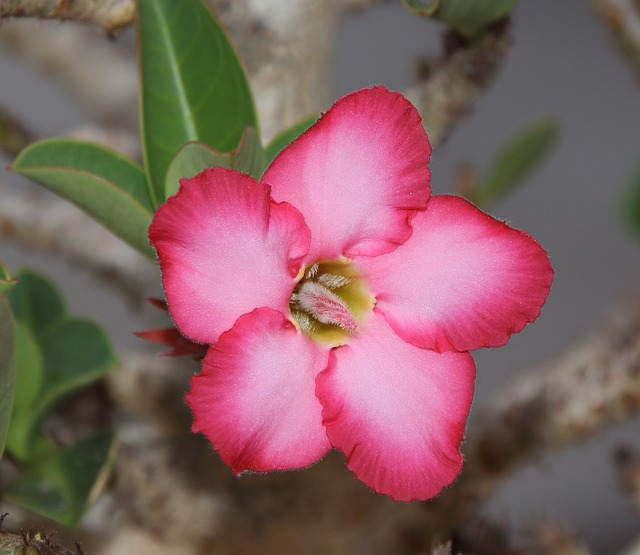
Choosing the right fertilizer for desert roses is essential for healthy growth and blooming. To select the perfect fertilizer, it’s important to consider the NPK ratio, phosphorus content, and other nutrients necessary for desert rose plants. These flowering plants require high amounts of phosphorus and potassium to support their growth and vibrant blooms. Granular fertilizers, such as those used for roses, are convenient to apply and allow you to visually observe the fertilizer to determine where it needs to be applied.
Bayer Advanced Rose & Flower Care is another effective option for desert roses, providing insect control, disease control, and fertilizer in one product. It is known to control various pests and diseases, such as aphids, Japanese Beetles, Lacebugs, Mealybugs, Whiteflies, Thrips, black spot, powdery mildew, blight, and rust. With the right fertilizer, your desert roses will have the nutrients they need to produce an abundance of mesmerizing blooms.
NPK Ratio Essentials
The NPK ratio is a crucial element in selecting the right fertilizer for desert roses. NPK stands for nitrogen (N), phosphorus (P), and potassium (K), and the ratio represents the relative amounts of these essential nutrients in the fertilizer. A 1:1000 or balanced NPK ratio are both suitable options for desert roses. Desert rose plants generally require 3 pounds of nitrogen per 1,000 square feet, which is a typical requirement for flower fertilizers.
It is recommended to apply fertilizer to the soil before the growth emerges in desert rose plants. Ensuring the proper NPK ratio will help your desert roses thrive and produce captivating blooms that will leave you and your guests in awe.
Phosphorus for Flowering
Phosphorus plays a pivotal role in the health and blooming of desert roses. Adequate phosphorus is essential for these plants to produce their stunning flowers. To add phosphorus to the soil, you can use fertilizers that contain the element, such as bone meal, rock phosphate, or superphosphate.
You can assess soil phosphorus levels by using a soil test kit or sending a soil sample to a laboratory for testing. By ensuring the right amount of phosphorus in the soil, your desert roses will reward you with mesmerizing blooms that will be the envy of your neighborhood.
Top Fertilizers for Desert Roses
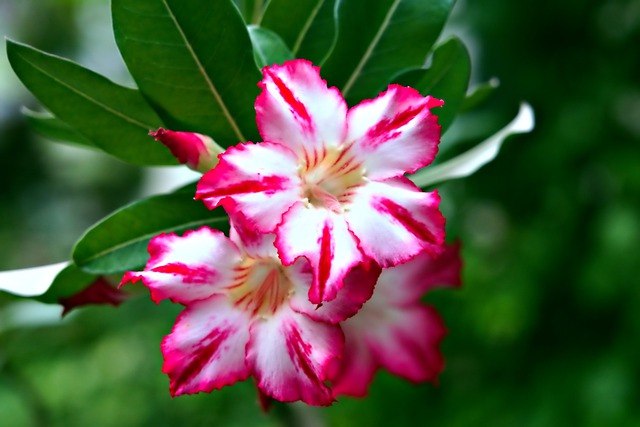
There are several top desert rose fertilizer options that will provide your desert roses with the nutrients they need to thrive, even in the challenging conditions of a fertilizing desert. These fertilizers can be divided into two categories: organic and synthetic. Organic fertilizers possess slow-release properties and offer a balanced nutrient profile, which is ideal for desert roses. Synthetic fertilizers, on the other hand, are fast-acting and can be customized to meet specific requirements.
Some of the top options for desert roses are water-soluble solutions by Miracle-Gro, balanced fertilizers with nitrogen, phosphorus, and potassium, and JR Peters Jack’s Classic Blossom Booster.
Fertilizers can be applied to desert roses using various methods, such as a canister, hose, or watering can. With the right fertilizer and application method, your desert roses will have all the nutrients they need to showcase their exotic beauty.
Organic Fertilizers
Organic flower fertilizer is composed of natural sources such as compost, animal manure, bone meal, fish emulsion, and seaweed extracts. These fertilizers are free from synthetic chemicals, offering slow-release and consistent nourishment to desert roses. Some examples of organic slow release fertilizer suitable for these plants include Jobe’s Organic All-Purpose Fertilizer, Neptune’s Organic Fertilizer, and Plant Magic Plant Food.
As an alternative to desert roses, Epsom salt, Alfalfa Meal, and Kelp Meal may be utilized. These alternative plant food sources can provide additional nutrients to the soil, ensuring your desert roses have all they need to produce breathtaking blooms.
Synthetic Fertilizers
Synthetic fertilizers are chemically manufactured materials, typically derived from non-renewable resources such as petroleum by-products, comprising minerals, gasses from the air, and inorganic waste materials. These fertilizers have several benefits, such as being straightforward to employ, supplying a reliable source of nutrients, and being readily available. Additionally, they are cost-efficient and can be utilized in a multitude of ways, including as a balanced fertilizer.
However, synthetic fertilizers can be detrimental to the environment if not utilized correctly. It is imperative to adhere to the instructions outlined on the fertilizer package and to utilize the appropriate amount of fertilizer for the specified plant. Additionally, it is essential to irrigate the plants following the application of the fertilizer to facilitate its absorption into the soil.
Fertilizing Schedule for Desert Roses
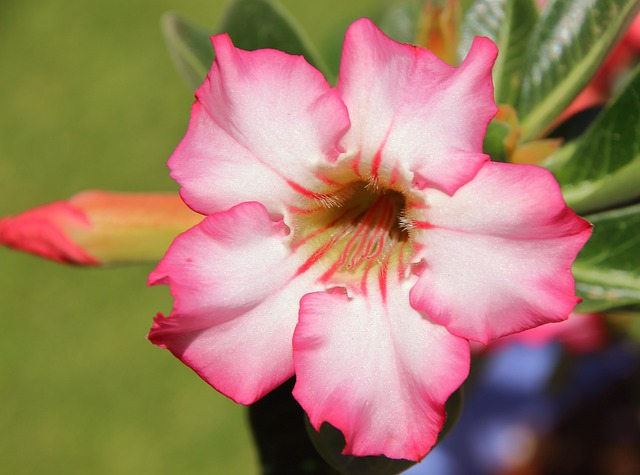
The fertilizing schedule for desert roses is crucial for their health and blooming. It is recommended to fertilize desert roses twice annually, during the spring and fall seasons. The optimal time to fertilize desert roses is every two to three months, and it is advised to refrain from fertilizing during the winter season.
When applying fertilizer to desert rose plants, it is essential to bear in mind that the roots of the plant necessitate a balanced supply of nutrients, particularly potassium. Excessive fertilization may result in no response to fertilizer, the attraction of fungi, or root rot.
By adhering to a proper fertilizing schedule and considering the necessary nutrients, your desert roses will flourish and produce awe-inspiring blooms.
Early Spring and Late Summer
The optimal time for fertilizing desert rose plants is during the early spring and late summer periods. During these seasons, it is recommended to avoid using high-nitrogen fertilizers during the first years of desert rose growth. Instead, it is advised to fertilize desert roses at least once a month during these seasons to support their growth and blooming.
By following this fertilizing schedule, your desert roses will have the nutrients they need to grow and bloom, allowing your desert rose to grow healthy and vibrant. The result will be a captivating display of exotic flowers that will make your garden or indoor space a true oasis.
Winter Dormancy
Winter dormancy is a period of decreased activity in desert roses when the plant ceases growth and enters a state of rest. During this period, the plant requires less water and should be brought indoors to protect it from freezing temperatures. To overwinter desert roses, it is recommended to bring the plant indoors, cease watering, and ensure it is in an area where it will not be exposed to freezing temperatures.
Once winter dormancy has passed, it is advised to slowly provide water to the plant and place it in a window with a sunny exposure. Subsequently, the plant can be gradually reintroduced to outdoor life. By understanding and respecting the natural dormancy period of desert roses, you can ensure their health and vitality throughout the year.
Proper Watering and Soil Management
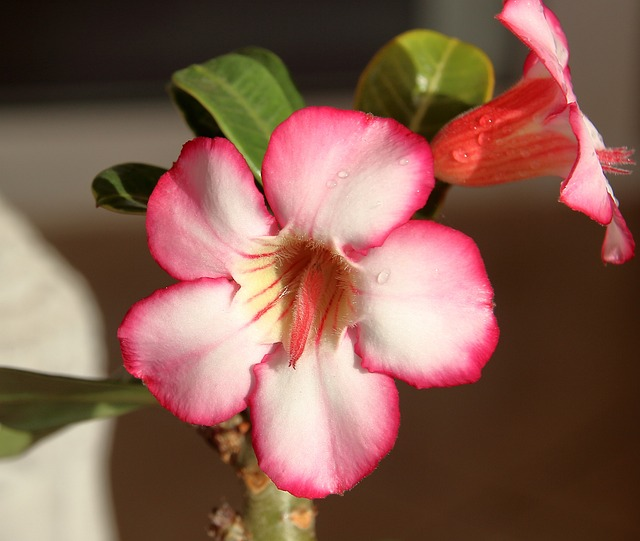
Proper watering and soil management is key for desert rose health. A well-drained soil mix that offers optimal drainage, such as a cactus or succulent mix, is necessary for desert roses. The soil should have a slightly acidic pH of 6.0 and should not become overly saturated with water.
It is recommended to water desert roses when the soil is dry. For optimal results, water deeply and allow the soil to dry out before watering again. By ensuring the right soil conditions and proper watering techniques, you can prevent common issues such as root rot and fungal infections, allowing your desert roses to thrive and showcase their exotic beauty.
Soil Requirements
Desert roses require specific soil conditions to thrive. A well-draining soil mix that provides optimal drainage, such as a cactus or succulent mix, is essential. The soil should have a slightly acidic pH of 6.0 and must not become waterlogged. For desert roses, sandy or gravelly cactus soil with neutral to acidic pH is the most appropriate.
By ensuring the appropriate soil type, pH, and drainage, you create the perfect environment for your desert roses to flourish. This will result in healthier plants that produce an abundance of mesmerizing blooms.
Watering Techniques
The recommended watering schedule for desert roses is regular watering throughout the year. During its growing season, maintain the soil moisture but avoid saturation. In the fall and winter months, significantly reduce moisture, watering only occasionally once a month or so.
To prevent rot, it is recommended to plant the desert rose plant in a container with adequate drainage holes. As desert rose plants can be prone to rot if the soil becomes overly moist, ensuring proper drainage and watering techniques is an important step in keeping your desert roses healthy and vibrant.
Pruning and Maintenance for Healthy Desert Rose Plants
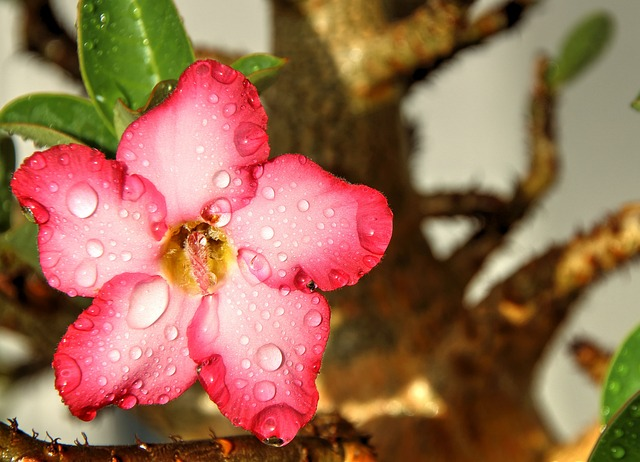
Pruning and maintenance play a crucial role in the health and appearance of desert roses. It’s essential to sterilize pruning tools before and after pruning to avoid the transmission of disease. Remove cold-damaged growth by pruning the affected branches back to healthy wood. Trim long, lanky stems back to a healthy bud or branch to promote new growth and maintain a healthy shape. Remove branches that rub or cross other branches by pruning them back to the main stem or branch.
Following these pruning practices will help your desert roses maintain an aesthetically pleasing shape while also stimulating new growth. Desert roses need the extra nutrition delivered by fertilizing twice a year. Spring and fall are ideal times to fertilize them. Water consistently during the spring and summer months.
By adhering to a regular pruning and maintenance schedule, your desert roses will be healthier and produce more abundant, vibrant blooms.
Pruning Techniques
Desert roses should be pruned every two years to promote optimal growth and a bushier appearance. Proper pruning techniques include sterilizing pruning tools, removing cold-damaged growth, trimming long, lanky stems, and removing branches that rub or cross other branches.
Regular pruning not only helps maintain the shape and appearance of your desert roses, but also encourages new growth and flowering. By following these pruning techniques, you’ll ensure your desert roses remain healthy and vigorous, producing captivating blooms that will delight you and your guests.
Fertilizing After Pruning
Fertilizing after pruning is critical as it encourages new growth and ensures the plant receives the necessary nutrients. Organic fertilizers, such as slow-release fertilizers, are ideal for desert roses as they provide a balanced nutrient profile. Synthetic fertilizers can also be used, but should be applied sparingly.
It is suggested that desert roses be fertilized in early spring and late summer, and should not be fertilized during winter dormancy. By following these fertilizing practices after pruning, your desert roses will have the nutrients they need to produce mesmerizing blooms and thrive in their environment.
Troubleshooting Common Desert Rose Problems
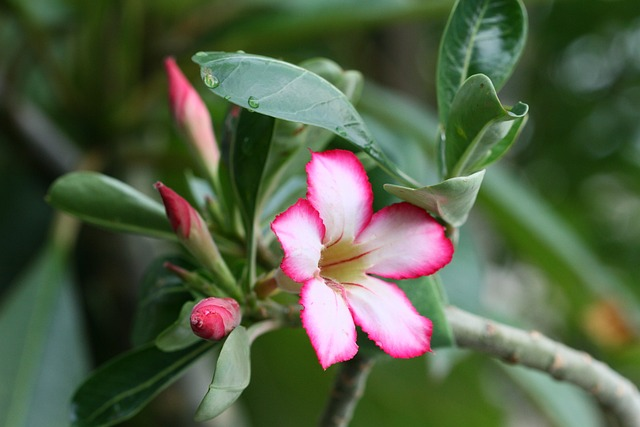
Despite our best efforts, problems can still arise when caring for desert roses. Common issues include root rot, pests, and diseases. To address root rot, remove any damaged leaves and stems, cut away affected roots, sterilize the knife, apply a fungicide, and replant in a well-draining potting mix.
For pests and diseases, such as spider mites and scale, early detection and intervention are crucial. By taking prompt action to address these issues, you can help your desert roses recover and continue to enchant you with their stunning beauty.
Root Rot
Root rot is a fungal infection that can lead to yellowing of leaves or sudden leaf loss. Winter pruning is a recommended approach to prevent root rot in desert rose plants, including the rose plant variety. If root rot is detected, it is advised to remove any damaged leaves and stems, cut away affected roots, sterilize the knife, apply a fungicide, and replant in a well-draining potting mix.
By catching root rot early and taking the appropriate steps to treat it, you can help your desert roses recover and continue to dazzle you with their exotic allure.
Pests and Diseases
Spider mites and scale are common pests that can affect desert roses. To detect spider mites, shake the infected foliage over a piece of white paper to reveal the small dots that are the mites, or look for fine webbing and eggs on the underside of the leaves. To control spider mites, apply a forceful spray of water on the underside of all leaves every several days, or apply insecticidal soap or neem oil to the underside of the leaves and all lower surfaces of the plant.
Powdery mildew is another issue that can affect desert roses, causing blister-like marks on upper leaf surfaces. Misting the leaves of your plant is a great way to address powdery mildew. Additionally, check the package instructions and apply suitable fungicide.
By detecting and addressing pests and diseases early, you can help your desert roses maintain their health and continue to produce magnificent blooms.
Alternative Plant Food Sources for Desert Roses
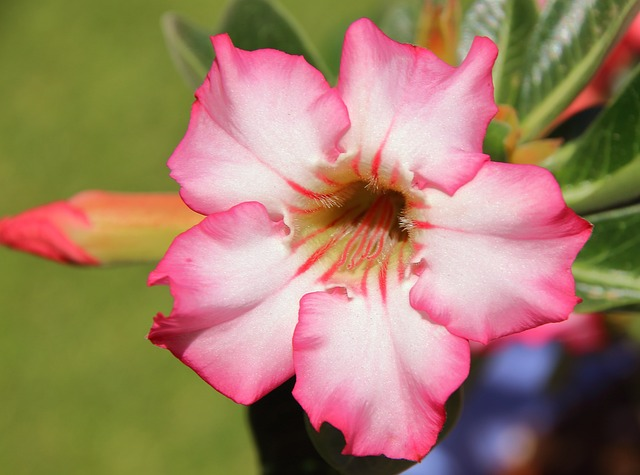
In addition to traditional fertilizers, there are alternative plant food sources that can provide supplemental nourishment for desert roses. These options include Epsom salt, Alfalfa Meal, Kelp Meal, bone meal, and liquid fertilizer. Utilizing these alternative sources can help ensure your desert roses get all the nutrients they need for optimal growth and flowering.
By supplementing your regular fertilizing routine with alternative plant food sources, you can provide your desert roses with additional nutrients and potentially reduce the amount of fertilizer needed, cutting costs and promoting better flower production. With proper care and the right blend of nutrients, your desert roses will continue to captivate you with their exotic beauty.
Beautiful Desert Roses
Caring for desert roses requires a keen understanding of their unique needs, from selecting the right fertilizer to proper watering and pruning practices. By following the comprehensive guidelines outlined in this guide, you can ensure your desert roses receive all the nutrients they need, along with the ideal growing conditions and care, to flourish and produce enchanting blooms. Embrace the rewarding journey of cultivating desert roses and transform your garden or indoor space into an exotic oasis that will leave you and your guests in awe.
Frequently Asked Questions
How often should desert rose be fertilized?
For optimal health and beautiful blooms, fertilize desert rose plants about once a month during the active growing seasons of spring and summer. Make sure to water lightly after fertilization to ensure that the roots absorb the nutrients. Prune in early spring to promote more flowers.
How do you make desert roses thrive?
For Desert Roses to thrive, they need full sun, regular watering during the summer, and a terra cotta pot with a cactus mix when repotting. In addition, when temperatures drop to 55 degrees or lower, it’s important to reduce watering significantly. Taking these steps will ensure your Desert Rose stays healthy and happy.
Do desert roses like coffee grounds?
Based on the available advice, it appears that desert roses do appreciate coffee grounds! This natural fertilizer provides many benefits to these plants, including improved drainage, an additional nutrient boost and increased soil acidity.
What fertilizer is good for desert rose?
For best results, a phosphorus-rich fertilizer should be used when growing desert rose. Bone meal fertilizer is an ideal choice as it is high in phosphorus and helps the Adenium obesum thrive.

David, the founder of The Garden Fixer, started with a passion for gardening in 2012. He has continued his passion for gardening and desire to improve his skills and wanted to share his journey and helpful knowledge with other like-minded individuals.
He launched The Garden Fixer as an outlet for those interested in learning more about Gardening in hopes they can take what they learn and apply it for themselves!

